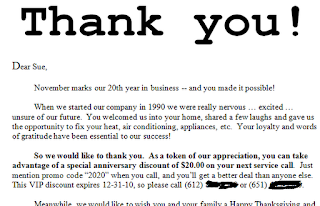Yesterday, I wrote about how to grow your business can grow in only 3 ways, one of which is to get customers to buy more often from you.
Today I'll give you a 4-step process you can to use to get them to do just that, with God's help.
You can do this in less than 45 minutes, in the morning or during lunch.
Here it is: 4 steps to getting customers to spend more money with your business ...
Step 1: Pray (5 minutes)You pray first because, matter how efficiently you do anything, you'll never be effective if you do the wrong thing. A humble prayer offered to God for the right reasons, helps you do the right thing -- every time.
Try this prayer for guidance ...
Heavenly Father, thank you for the many good things you make possible in my business and in my life. You are the source of every good thing I have. I ask You now for guidance in growing my business. Specifically, I ask you for ideas to help me serve my customers better so that they purchase more than once from me. I thank you for hearing this prayer and for the guidance you offer, for the good of all involved. I thank you with confidence for the insights you now provide to me, in the name of Jesus Christ, your son. Amen.
Step 2: Brainstorm 20 Ideas (15-30 minutes)Now comes the fun part. With God's guidance, you will now put pen to paper and WRITE (not type, not daydream) down ideas until you get at least 20. Not 5, not 17 -- 20.
Why 20?
By forcing your brain to hand over 20 ideas, you blow past the easy and logical one that are likely to come out in the first 5 or 10. You absolutely will get at least 2-3 creative, new ideas doing this that you would not any other way.
Start by writing this question at the top of a blank sheet of paper: "How can I get my customers to buy more than once from me?"
Then, start writing. Crazy ideas, brilliant ideas, old, or new, don't stop and don't censor yourself until you get to 20.
You have God's help, remember? You can do this.
Try these ideas for starters ...
- Say "Thank you" -- Mail a thank-you letter to every customer within 1 day of their purchase. Remind them to take advantage of special pricing on your most-popular items within 30 days.
- New offers -- Do your customers know about ALL the products or services you offer? Example: if you run a law firm, the same people who need your help creating a pre-nuptial agreement are eventually going to need a will, too.
- Loyalty program -- Why should customers buy from you again? How can you reward them for this with, say, a gift for every 2-10 purchases?
- Newsletter -- Do you publish an email or paper newsletter and send it to customers every month? By keeping our name in front of customers, you greatly increase the likelihood that they will buy again. Because it's not their job to remember your name.
- Reactivate old customers -- Can you contact all dormant customers by email, fax, phone or postal mail? Thank them for past patronage and make them a special offer that compels them to buy from you again.
Step 3: Prioritize Your Ideas (5 minutes)After you come up with at least 20 ideas, it's time to prioritize them. What's the best first thing you could do to get more customers? The second? Third?
Stop with your top three, for now. Otherwise, you'll try to do to much and end up doing nothing.
Step 4: Take Action (5-15 minutes)Never leave the site of a brainstorming session without taking at least one step toward implementing your best idea.
Tip: If you have time, sit down and actually put your new idea completely into practice.
But in any case, do something -- anything -- right away to build momentum.
That's it for this 4-step, God-guided process for growing your business by getting customers to buy more than one time from you.
I hope you've found this series helpful. If so -- or if not! -- please comment below and tell me what you think. More importantly, tell me what you're going to do next.



